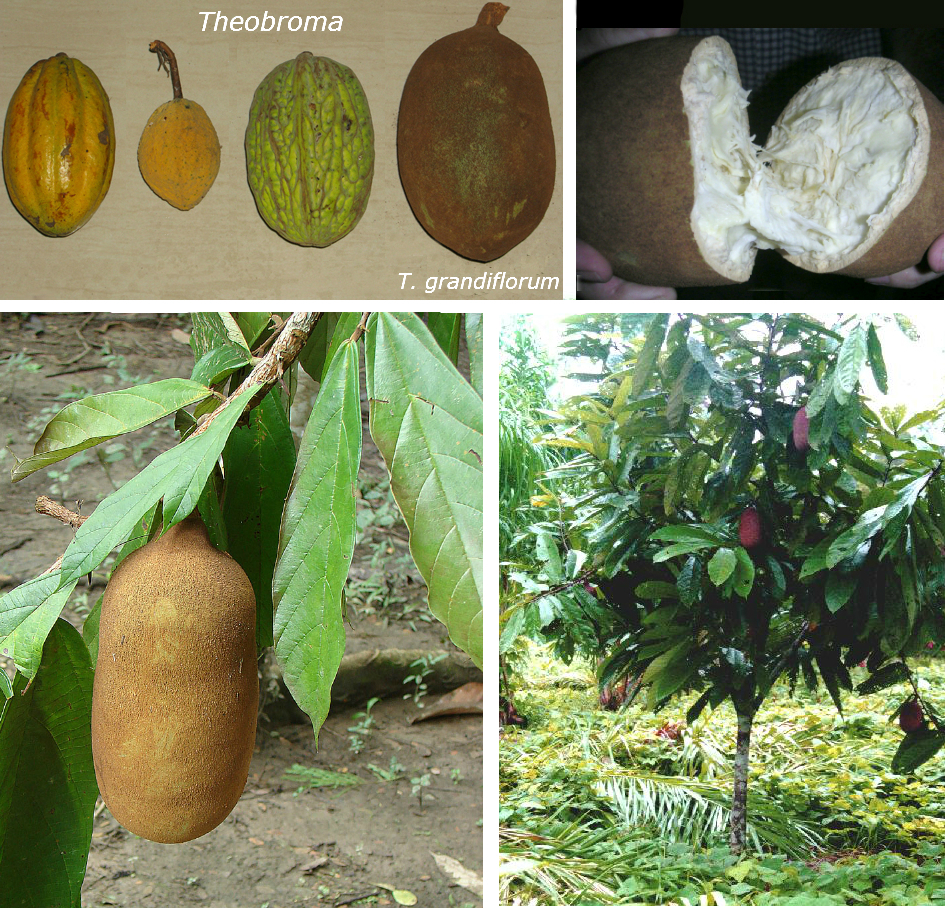Theobroma grandiflorum (Willd. ex Spreng.) K.Schum. - Sterculiaceae - cupuaçu (port.), cupuassu, copoazú, Cupuaçu, Großblütiger Kakao
Evergreen tree, up to 15m tall, native to tropical South America; leaves simple, alternate, upper surface bright-green and pubescent, underside grey; fruit a strong and pleasant smelling drupe, up to 25cm long, smooth outside, endocarp white, soft, sour-tasting.
„The cupuaçu is sustaining heavy genetic erosion. Its centre of diversity is in a subregion of southern Para, where there has been intensive destruction of its habitat through deforestation as well as through the construction of the Tucurui dam which flooded 2300 km2 of primary vegetation in the basin of the Tocantins River, where the species is still abundant in its wild state… Four species of Theobroma have been described as producers of edible flesh: T. grandiflorum, T. canumanense Pires & Froes, T. subincanum Martius, (Cupuí in Brazil and Cacau de monte in Colombia) and T. tricolor Humb. & Bonpl., which is a small tree distributed from western Amazonia to southern Mexico. Chocolate is also made from the seeds of these species. The basins of the Napo, Putumayo and Caquetá Rivers in the upper Amazon appear to be the centre of genetic diversity of T. cacao, although T. grandiflorum is found in southern Para in Brazil, and in Tocantins, Tapajós, Xingu and Guama.“
http://www.fao.org/docrep/t0646e/T0646E0k.htm
„The white pulp of the cupuaçu is uniquely fragrant (described as a mix of chocolate and pineapple), and It is frequently used in desserts, juices and sweets. The juice tastes primarily like a pear, with a hint of banana. Cupuaçu is touted as a possible superfruit flavor.“ https://en.wikipedia.org/wiki/Cupua%C3%A7u
Components of the flavor extract from the fruit pulp (vacuum distillation) were esters like ethyl hexanoate, ethyl butanoate, ethyl 2-methylbutanoate; alcohols like 2-methyl butanol and linalool; and (Z)-3-hexenal. The extract showed a very fresh, fruity-estery profile, but the acidic character of the fruit flavor was under represented. The fibrous part of the pulp released a typical acidic smellwhen rubbed between the fingers. The acidic methanolic extract from the fibers contained formic, acetic, 4-oxo-pentanoic, succinic, fumaric and malic acid. Formic, acietic, propanoic, butanoic, and 2-methyl butanoic acid should contribute mainly to the acidic odor of the fruit pulp. An ether eluate from RP-18 adsorbed fruit juice showed a very appealing fruity-sweet flavor. GC-O showed strong flavor impressions provoked by butanoic acid, (Z)-3-hexenal, (Z)-3-hexenol, ethyl hexanoate, methyl nicotinate, and methyl (E)-5-hydroxy-2-hexenoate. Several trace constituents were recognized to deliver major contributions to the overall flavor profile, like methional (potato-like), 2,5-dimethyl-4-hydroxy-3[2H]-furanone (fruity caramel strawberry), 2-ethyl-5-methyl-4-hydroxy-3[2H]-furanone (intense caramel), and vanillin (intense vanilla-like). Conventional simultaneous steam-distillation-extraction (SDE) produced an extract with cooked flavor together with fruity notes and an additional strong bread-like flavor impression. The identity of the bread-like smelling component could be proved to be 2-acetyl pyrroline, the impact component of bread flavor and cooked rice.
[Fischer, Norbert, Franz-Josef Hammerschmidt, and Ernst-Joachim Brunke. „Analytical investigation of the flavor of cupuacu (Theobroma grandiflorum Spreng.).“ ACS symposium series (USA). 1995]
„The total quantity (11.7 mg/kg of pulp) of aglycones released by enzymatic hydrolysis of the glycosidic extract indicates a significant aroma potential for cupuacu. Among the 47 aglycones identified, 24 are not present in the free volatile fraction, among them, 4-methylguaiacol, 4-propylguaiacol, 2,6-dimethyl-octa-1,7-dien-3,6-diol, 2,6-dimethyl-oct-7-en-1,6-diol, homovanillic acid, 2-methyl-but-3-en-1-ol and acetic acid. The quantitatively most important aglycones are 3-methyl-butan-1-ol, 2-phenylethanol, linalol, (Z)-2,6-dimethyl-octa-2,7-dien-1,6-diol, butan-1-ol and hexan-1-ol.“
[Boulanger, Renaud, and Jean Crouzet. „Free and bound flavour components of Amazonian fruits: 3-glycosidically bound components of cupuacu.“ Food Chemistry 70.4 (2000): 463-470]
„Forty-five volatile compounds were identified and 14 tentatively identified in cupuaçu (Theobroma grandiflorum) pulp using solid phase extraction on XAD-2 and simultaneous distillation extraction. Among them, 35 compounds were reported for the first time in this fruit. The olfactive characteristics of several compounds, separated after solid phase extraction, and their odour activity values showed that linalool, α-terpineol, 2-phenylethanol, myrcene, and limonene were contributors of the cupuaçu pleasant, floral flavour. Ethyl 2-methylbutanoate, ethyl hexanoate and butyl butanoate were involved in the typical fruity characteristics of cupuaçu. Diols (2,6-dimethyl-oct-7-en-2,6-diol, (E)-2,6-dimethyl-octa-2,7-dien-1,6-diol, and its (Z) isomer) and methoxy-2,5-dimethyl-3(2H)-furanone were possible contributors of the typical exotic odour. Moreover, hexadecanoic acid can be considered as a contributor of the grassy, heavy odour of cupuaçu.“
[Free and bound flavour components of Amazonian fruits: 2. cupuacu volatile compounds., Boulanger, R., Crouzet, J., Flavour and fragrance journal, Vol.15(4), 2000, 251-257]
„Volatile compounds were isolated from copoazú (Theobroma grandiflorum Schumann) fruit by liquid-liquid extraction at two different pH values of 3.3 (natural) and 7. The volatile extracts were analyzed by capillary GC-FID and GC-MS. Among the 56 compounds identified at two pH values, many of them were only present in the lower pH extract, confirming the presence of bound compounds in copoazú. Ethyl butanoate, ethyl hexanoate and linalool were the major constituents found in copoazú fruit.“
[Volatile compounds of copoazú (Theobroma grandiflorum Schumann) fruit., Quijano, C. E., Pino, J. A., Food chemistry, Vol.104(3), 2007, 1123-1126]

„Upper left photo: Frutis from 4 Theobroma species, from left to right: T. cacao, T. speciosum, T. bicolor, and the amphisarca of T. grandiflorum. The rest of the photos are from T. grandiflorum.“
CC BY-SA 3.0, Author upper left: The original uploader was Roy Bateman at English Wikipedia (Transferred by IKAl); upper right: BjoernS, bottom left: Dick Culbert from Gibsons, B.C., Canada; bottom right: M.-A. Wolf, montage by User:RoRo Wikimedia Commons
